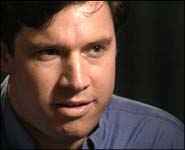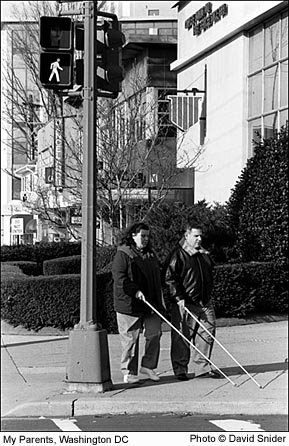|
A
Dream Come True
Dispatch by David Snider
ABC News Nightline UpClose
|

|
Some things happen
at the Right Time, and sometimes, that can take years to come about.
I was a very fortunate person on the evening of August 30, 2002, when
the Nightline UpClose program focused on my family's story and my photographs
of my parents.
The interest that generated this attention is the fact that both of
my parents were born blind, and that I seem to be the only photographer
who's photographed his blind parents. The pictures themselves are my
best body of work as a photographer. It was my dream to one day show
my pictures of my parents to millions of people. I never thought it
would be on ABC's television signals.
Over the past six
years, I'd learned from Dirck Halstead and Rolf Behrens about the Platypus,
and how to evolve into a new kind of visual journalist through video.
I'd gotten pretty good as a shooter, producer and editor, and developed
stories that were broadcast on four previous shows on ABC News Nightline.
I concentrated on the Craft, and eventually I got pretty good at shooting
and editing my own stories
Earlier this summer, I was inspired by an epiphany about bringing television
and photography together in a dynamic and cinematic fashion. I knew
how powerful Ken Burns' films were, and how they used pictures as a
crucial element through the use of slow zooms. Resolved to make something
special from my photography, I filmed an interview between myself and
a friend, then went to work, editing and composing on Final Cut Pro
to get my still photos to move slowly, exquisitely slowly, on the screen.
My strategy was
to use photography for 80% of the video's content, and use the narration
from the interview for the narrative backbone of the piece. Through
this combination of media, I tried to create a cinematic feel through
careful pacing and editing, things that I'd learned from my friend Rolf
Behrens, who'd co-produced and edited my first two Nightline shows.
After three months, I had a finished product, and I designed and created
a website called Every
Picture and uploaded a massive 40 megabyte video clip, almost 16
minutes long, about my photography.
I showed the video
to my friends, and then I called Tom Bettag, Nightline's Executive Producer,
and asked him to take a look.
Tom and I had always
gotten along really well. He and Ted Koppel bought my first story about
Ellen Bomer in 1999, and all four times I'd been broadcast on TV, it
was on Nightline. Tom said he was very busy, after having developed
the second Nightline program, UpClose, but he said he'd get around
to looking at it. Sure enough, the next day, he called me back and said
that he wanted to feature my work on the UpClose program with
a new interview with Chris Bury.
The dream was becoming a reality.
 I
came down to the offices and Tom and I discussed the show. He said that
he believed that photography could work very well on television, and
he loved the way I used my pictures in my video, and I was given control
over their use in the program. He doesn't always get directly involved
as the sole producer very often, because he's got a great staff of producers,
but Tom knows that I'm very hands-on about everything I do and this
was very personal to me, so he would be my producer. This guy is one
of the smartest and best producers in the business, and I trusted him
and Richard Harris, Nightline's Senior Producer, to bring my family's
story to the nation. I
came down to the offices and Tom and I discussed the show. He said that
he believed that photography could work very well on television, and
he loved the way I used my pictures in my video, and I was given control
over their use in the program. He doesn't always get directly involved
as the sole producer very often, because he's got a great staff of producers,
but Tom knows that I'm very hands-on about everything I do and this
was very personal to me, so he would be my producer. This guy is one
of the smartest and best producers in the business, and I trusted him
and Richard Harris, Nightline's Senior Producer, to bring my family's
story to the nation.
On August 23, 2002, I got on my bike and rode the five minute commute
from my apartment to Nightline's downtown DC offices at the ABC bureau.
I was escorted into a small studio where three cameramen and two soundmen
were setting up their gear. I'd brought a few prints and my Leica, as
well as my G4 laptop with all of the 50 pictures from my portfolio.
Chris Bury and I said hello and sat down for the one-hour interview.
Inside my head, I was organizing the stories and statements and expressions
that I'd been accumulating for most of my life. When the interview began,
most of them rolled out as good, solid sound bites. I was able to get
most of my heartfelt expressions out of my head in a good order. A couple
of times I got a dry mouth, feeling a little nervous and self-conscious
and drank some water.
At the halfway point, I pulled out my laptop and started showing the
complete portfolio of pictures to Chris. One by one, everyone else came
and stood behind him and watched the pictures come on the screen. We
went back to the interview and talked about the pictures some more.
I said some things that I rarely discuss openly, including my dream
about my father being able to see, and my willingness to trade 30 years
of my life to have him be able to see what I look like.
A few days after the interview Tom called me and said that the program
would go on the air on Friday, August 30, and I should get ready. I
came in and we went over his edit of the interview, and decided to insert
photographs into the video at 12 intervals throughout the show. I was
given a DV tape with a "radio cut" edit from one camera's
point of view, and I brought it into my Mac. I then brought my prepared
images into the video and made them slowly zoom and pan across the screen.
I used 55 pictures, taking up 8 minutes and 20 seconds of airtime with
my photos on screen.
I delivered a finished DV tape of my animated photos, which were patched
into the Avid system and included in the edited show, just as I'd prepared
them. I watched a final edit of the show on Friday afternoon and went
home, satisfied that the show would be good. Tom was positive about
everything I did, and I felt that he did a great job too.
I watched the show here in my apartment, in the same room that I had
filmed myself three months before, and began the work that now propelled
my life forward onto national television. My friends came over, and
even though they were excited, I was exhausted but satisfied, finally,
to see that my photos were in front of millions of people at that very
moment
After the show
my phone rang off the hook. My parents called and said that they were
very happy with the program. Their opinion meant the most, and they
said that I represented them and the blind community well, which is
what my life's mission has been for twelve years.
The dream came true.
|

 I
came down to the offices and Tom and I discussed the show. He said that
he believed that photography could work very well on television, and
he loved the way I used my pictures in my video, and I was given control
over their use in the program. He doesn't always get directly involved
as the sole producer very often, because he's got a great staff of producers,
but Tom knows that I'm very hands-on about everything I do and this
was very personal to me, so he would be my producer. This guy is one
of the smartest and best producers in the business, and I trusted him
and Richard Harris, Nightline's Senior Producer, to bring my family's
story to the nation.
I
came down to the offices and Tom and I discussed the show. He said that
he believed that photography could work very well on television, and
he loved the way I used my pictures in my video, and I was given control
over their use in the program. He doesn't always get directly involved
as the sole producer very often, because he's got a great staff of producers,
but Tom knows that I'm very hands-on about everything I do and this
was very personal to me, so he would be my producer. This guy is one
of the smartest and best producers in the business, and I trusted him
and Richard Harris, Nightline's Senior Producer, to bring my family's
story to the nation.